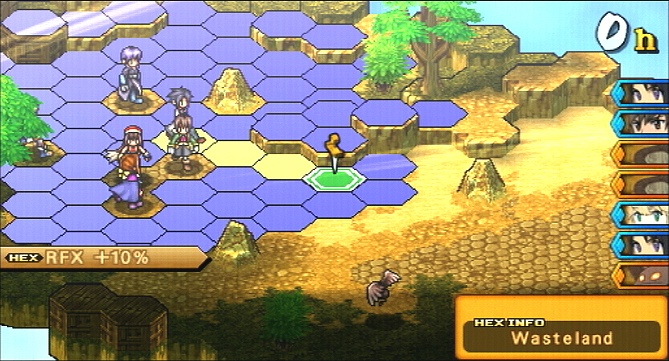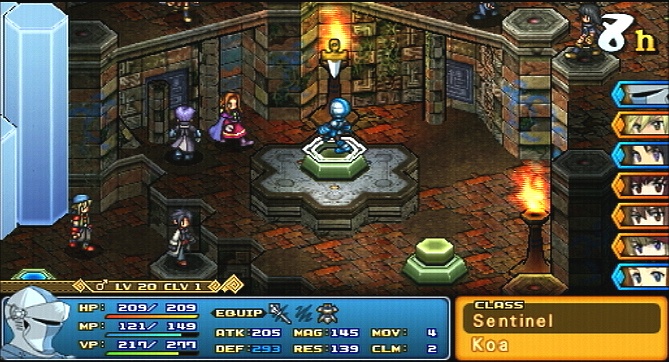Wild ARMs XF is the latest title to join the PSP's growing list of strategy role-playing games. It's also the first Wild ARMs to go entirely down the tactical route, with developer Media Vision successfully maintaining the franchise's Wild West theme. While it features some interesting concepts that will appeal to die-hard fans of the genre, the execution is often cumbersome and tedious.
The plot follows heroine Clarissa Arwin as she ventures with her brother, Felius, to the kingdom of Elesius, one of the sole remaining havens in the barren and war-torn world of Filgaia. After a tragic incident kills the kingdom's heir, Princess Alexia, Elesius becomes subject to the rule of an evil council that harasses and slaughters the populace via a special guard. The heroic duo is swept up in local politics as Clarissa declares herself to be the assumed-dead princess, leading a rebellion against the council.

Though XF retains the genre staple of slaying bad guys one turn at a time, there are some additional elements mixed in to shake things up. The biggest difference is that XF's movement tiles each have six sides, unlike the square tiles that appear in such games as Final Fantasy Tactics. The hexagonal tiles allow you to perform formation arts when you successfully surround opponents or sandwich them in a line. This increases a character's attack damage for a single hit when you've appropriately positioned allies. Your opponents can also use formation arts, which add some interesting strategic elements to the gameplay when small swarms of enemies are surrounding you as you're trying to surround them.
XF has a novel class system featuring 16 base jobs that successfully differentiate themselves from traditional class offerings of similar games. In the place of mages and knights are elementalists and sentinels, which technically perform the same jobs but still contradict the mold. For example, geomancers, whom Final Fantasy veterans may remember as elemental manipulators, focus on quickly traversing the map or locking foes in place instead of specializing in terrain-type offensive magic. For additional variety, the primary cast sports exclusive jobs, but there is little impetus to use them because you'll be switching characters often.
The game's mission objectives vary, but what appears good on paper is frustrating in practice. In some cases, they seem too ambitiously designed and undermine the class-based system. One of the early escort missions requires you to constantly heal your charges. This forces you to switch to the gadgeteer class, which is the only one with the ability to use items on others, because the loss of a single villager ends the game. What's vexing is that every mission forces you to bring in appropriate classes to complete it instead of letting you play the classes you want. Furthermore, class switching itself automatically de-equips everything from your characters, including items, so don't be surprised if you lose a few fights because you forgot to reequip, though a favorites option slightly lessens the risk.
Mission objectives also aren't very forgiving. In certain situations, losing one ally in an escort mission or being spotted by a single guard in a stealth mission means a redo. The stealth missions are especially troubling because you're forced to learn the patrol patterns of guards with extended lines of sight. If you position yourself behind a guard, even at a great distance, he'll turn and spot you for an instant game over. Thankfully a battle-restart option saves you from constantly reloading.
Wild ARMs XF suffers from some balancing issues. Some opponents, though only a few levels higher than your characters, are nearly untouchable. Fortunately, the game recognizes this and orders the invincible foes to retreat, but this is usually after said supermonsters have gotten in some cheap hits. At other times, you'll easily plow through enemies on either a very small or large map, which introduces a pacing problem: Certain class limits and base stats cause some characters to slowly traverse areas with elevated terrain. Characters with a low movement range/climbing skills have a difficult time ascending cliffsides while those boasting only certain job or skill sets can break/move objects to make it possible for your characters to gain the higher ground. This makes navigating even the simplest of free battles frustrating and tiresome because you either have to wait for bad guys to get within range or spend the next 20 turns trying to make a path.
The game's vitality point system is another annoyance. Characters lose a set number of points each turn depending on the weight of their equipment. If VPs reach zero, your rebel army's health points dwindle to one, making it an easy target for your probably misbalanced and therefore nearly insurmountable bosses. Though the masochistic might view this as a challenge, it gets very aggravating the further you progress when your unit's heavy gear increases the rate at which it loses VPs.

Though Media Vision didn't include a multiplayer option or side quests for higher replay value, the game does utilize an item-synthesis system that enables you to craft special equipment from items found by drifters you've created and sent scouring the world for loot. Customizing drifters also adds to the replayability, and the game offers a full bevy of options. These allow you to roll for base stats before selecting class, sex, voice, name, and level at a cost.
XF's cliche dialogue and plot elements are presented via vividly colored and unintentionally humorous cutscenes featuring anime-style character portraits. The voice-overs are irritating unless you're craving the overacted anime variety, but at least there's an option hear them in Japanese for authenticity. Fortunately the game's subtle background stills and vibrant 3D battle maps coupled with flashy spell effects and cute character sprites, help fend off aesthetic boredom. XF boasts the same great Western-style RPG melodies of its console predecessors, with the added bonus of a music room where you can listen to any of the game's 20 tracks on demand.
Wild ARMs XF captures the feel of its namesake series and successfully incorporates hexagon-based maps into its tactical gameplay. But even its formation arts and class system can't hide the overly ambitious, frustrating, and very unforgiving trial-and-error mission design. You might want to look elsewhere for your strategy RPG fix.